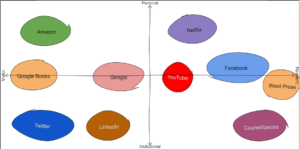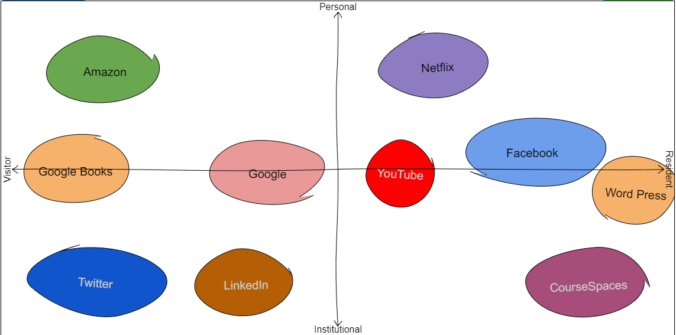
Above is the V and R mapping that I have come up with. Looking at the map, one could easily see that most of my engagements online are institutional. This is because one of the reasons that I go online is because of my classes. There are sites in the map that I would not discover if not for my classes. For example, I have no idea what WordPress is and I also do not know how it works. Since WordPress is required in one of my subjects so I was mandated to create an account and learn how it works. In the long run, I learned how to use WordPress and I kind of liked blogging so I ended up using it for personal reasons. My V and R mapping got me thinking that if I am not a student, I would not spend so much time online. However, since it is already the digital age, I am pretty sure that when I started working one day, most of my activities online will be work related. Therefore, my V and R map will still be filled with institutional online activities.
With regard to work, some of the digital platforms that students use in order to develop their professional network are LinkedIn and Facebook. According to Johnson (2019), LinkedIn is a “social network that focuses on professional networking and career development.” Users can post their resumes and search for jobs using LinkedIn. Not only that, LinkedIn also allows their users to post updates and interact with other people. In addition to LinkedIn, Facebook also has a feature that allows students develop their personal network and this feature is called Facebook Jobs. Facebook Jobs allow users to search for jobs. Also, just like LinkedIn, Facebook also allows users to interact with professionals.
As a student, I plan to create my online portfolio through creating a WordPress website. In this website, I will create a professional identity that employers would like. I will also publish articles on economics that people can easily relate to. I want people to visit my site whenever they wanted a financial advice or they wanted to know some life hacks on budgeting their money. In order to interact with my audience, I will ask them to leave questions and I will answer them in my next blog. I will also promote my website in my social media so that my personal network can learn about my website. Through this website, I believe that I will be able to create a good digital reputation. This is because my site visitors learn from the articles I write and they may even consider me an expert in the field. Also, if ever a local employer would stumble upon my blog, he/she will be able to assess how much I know about my profession. Also, the blog will be a solid evidence that I am serious with the career path that I have taken to the point that I am determined to share my knowledge to others.
Reference
Johnson, D. (2019, September 6). ‘What is LinkedIn?’: A beginner’s guide to the popular professional networking and career development site. Retrieved from https://www.businessinsider.com/what-is-linkedin
OCLC. (n.d.). Visitors and residents mapping app. Retrieved from https://experimental.worldcat.org/vandrmapping/signIn

Recent Comments